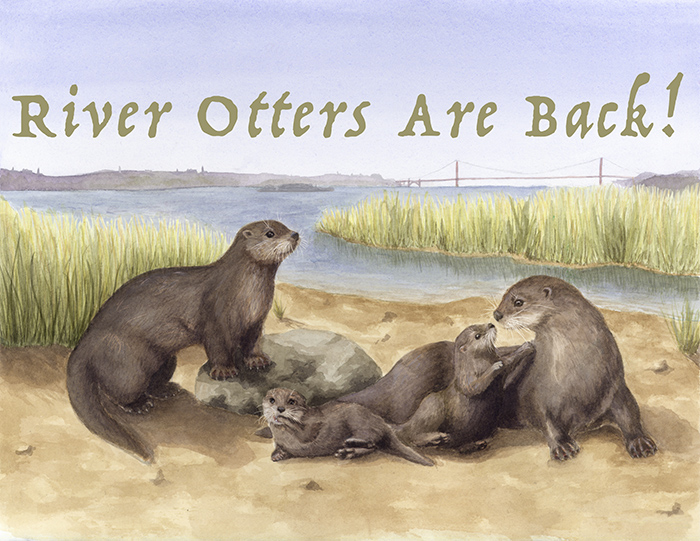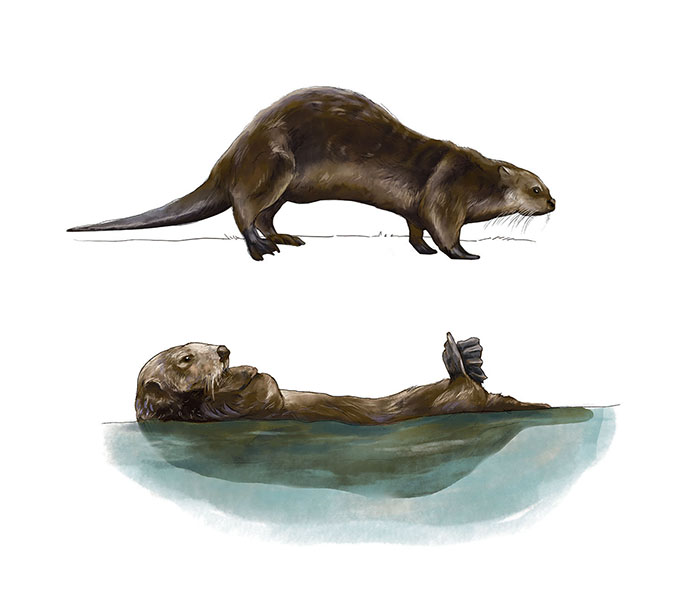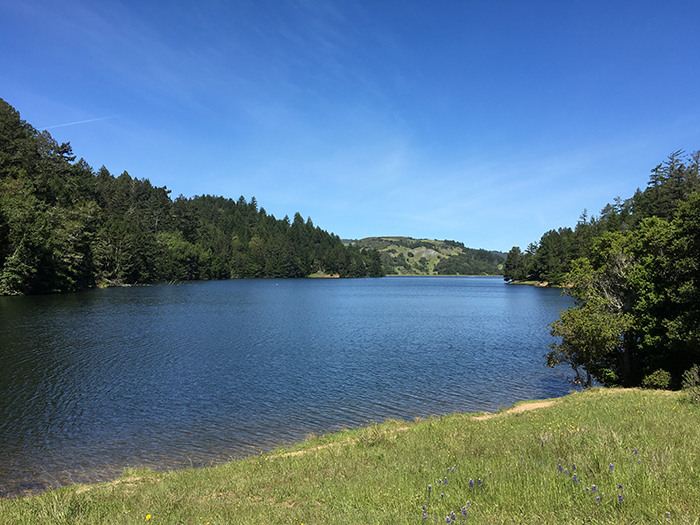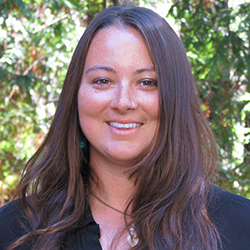
|
| Illustration: Kristin Bell |
Playful otters have returned to streams and lakes near San Francisco, but will they stay? Bethany Augliere tests the waters. Illustrated by Kristin Bell and Jillian Ditner.
“I hope we see them,” says Megan Isadore, scanning Lake Lagunitas with binoculars. We’re 14 miles north of San Francisco in search of North American river otters. After weeks of January rain, my sneakers squelch in the mud as we hike along the water’s edge, carefully avoiding newts. Otters live here to hunt for fish and frogs; their sinuous bodies weave through cattails and fallen logs. But today the lake is quiet, and we see none of the stealthy mammals. “It’s difficult at this time of year,” Isadore says, noting that mothers are tucked away in dens with their new pups. “The otters are more elusive than usual.”
The mere presence of otters here would have surprised California ecologists just two decades ago. The animals once roamed waterways all across North America. But by the early 1900s, two centuries of unregulated fur trapping for their glossy chocolate pelts had nearly wiped them out. And as growth and pollution degraded otter habitats in the San Francisco Bay Area, local populations dwindled further. The last river otter sightings here were in the 1960s.
Today, about 50 otters have returned to a 120-mile stretch of coastlines and lakes just north of San Francisco. It seems they are thriving among the crowds. Their reappearance has prompted a basic question: Why did they come back?
The answer is in the water, believes Isadore, who cofounded the River Otter Ecology Project in 2012. “The bottom line is that without healthy watersheds, we don't have river otters,” she says. Their livelihood is linked to the water. By studying photos, footage from motion-activated cameras, and pungent otter scat, Isadore’s team is learning how these prodigal otters are making a living in this populated region. But many threats remain, and it’s too soon to know whether the otters are here to stay.
Cute but fierce
River otters are top predators in North American wetland systems. They devour fish and other prey, keeping ecosystems balanced. Despite their name, they inhabit more than just rivers. “Otters need fresh water to keep their fur clean and to drink, but they're very comfortable in any kind of water. They are perfectly happy to hunt in the ocean,” says Isadore. Indeed, river otters fish in the ocean, along the coasts of bays and wetlands, and in freshwater lakes.
At a sleek 20 pounds or so, otters are designed for an aquatic lifestyle. Clusters of long facial whiskers help them detect prey in murky water, and their double-layered fur keeps them warm to fish year-round. In northern regions, they even hunt under the ice. Otters have powerful tapered tails, flaps that close both their nostrils and ears when they dive, and big webbed feet. “I call them their flappy little flipper feet,” Isadore says. They can stay submerged for a minute or more.
One glance at the scaly, feathery contents of otter scat reveals just how voracious they are. They eat fish, birds, crayfish, turtles, frogs, mussels, and small mammals such as mice and muskrats. One otter in Pleasanton decided to feast on local pond turtles, upsetting young neighborhood children, Isadore says. In the 1990s, otters started hunting pelicans at Rodeo Lagoon, just north of San Francisco. The versatile predators can’t afford to be picky; they must consume up to 20 percent of their body weight every day to sustain their constant activity.
 |
| Illustration: Jillian Ditner |
| The North American river otter (top) is much sleeker than its bulky cousin, the California sea otter (bottom). |
Casual viewers sometimes mistake river otters for their larger fluffier cousins, sea otters. “If you see an otter swimming on its back with prey, smashing shells on its chest, that is very definitely a sea otter, not a river otter,” says biologist Tim Tinker of the U.S. Geological Survey and UC Santa Cruz. Like most nearshore marine mammals, river otters give a wide birth to the hefty and aggressive 100-pound sea otters when they cross paths, Tinker says. Both animals are members of the weasel family, but river otters are much more suited to both land and water.
Scientists don’t quite know when the Bay Area’s otters started to return. Experts speculate their recovery is related to the statewide ban on hunting of all species of otter, including sea otters, in 1962. Ten years later, the federal government established the Clean Water Act, and the sludgy waterways near San Francisco gradually improved.
Since then, many Bay Area restoration efforts have aimed to conserve and protect tidal marshes and endangered species, such as coho salmon and clapper rails. In 1999, about 200 scientists, managers and regulators created a plan for restoring wetlands, called the Baylands Goals. “We’ve made huge progress in a really short amount of time,” says ecologist Letitia Grenier, a scientist with the San Francisco Estuary Institute. Now, about 72,000 acres of restored wetland habitat line the bay’s shoreline, up from 45,000 acres in 1998. Top predators like otters balance the ecology of these revitalized ecosystems.
In the early 2000s, Isadore first noticed the slinky carnivores while working as a volunteer with a coho salmon recovery project in Lagunitas Creek. The otters were occasional visitors to the creek, but by 2008 they were regulars. When Isadore became curious enough to investigate their population status, she was surprised to learn that otters weren’t even on the California Department of Fish and Wildlife maps for the Bay Area. “They had been making an under-the-radar comeback,” she says.
 |
| Photo: Bethany Augliere |
Megan Isadore, cofounder of the River Otter Ecology Project. |
|
Isadore’s colleague Paola Bouley traced the first sighting to Rich Stallcup, a local biologist who had seen otters in Marin County’s Walker Creek in 1989. But there was no organization to study the animals, and even basic details of their biology were mysterious. So, Isadore launched the River Otter Ecology Project (ROEP) with Bouley and her husband, Terrence Carroll. They also created the Otter Spotter Citizen Science Project to collect public insights into otter lives.
One particular otter helped put ROEP on the map. In fall 2012, “Sutro Sam” lived in the dilapidated Sutro Bath pools on the shore of western San Francisco. Sam, the first otter seen in the city in memory, was a healthy lone male who swam all day in the pools, feasting on resident carp. He became an instant media sensation. Crowds of people went to watch him, and he didn’t seem to mind, says Isadore. Some people even brought their dogs to swim with Sam, assuming he was lonely. (Biologists advise against this, and Sam never let the dogs approach closer than a few feet.) Eventually, he ate all the fish and disappeared. He may have left “to go looking for love,” Isadore says.
“He was so charming that he really caught the attention of people, and otter spotter sightings started pouring in. Sutro Sam was the best thing to happen to our project.”
Otter quest, and questions
Even with help from otter spotters, biologists still don’t know how many river otters live here, whether they’re spreading out, and their family ties. To find out, Isadore’s group set up 25 infrared motion-sensor cameras at various locations along 120 miles of shorelines in coastal and inland Marin County, north of San Francisco.
 |
| Photo: Bethany Augliere |
| Bon Tempe Lake in Marin County, California, one of the team's study sites. |
|
Volunteers visit the cameras every week. They check batteries and memory cards, and they search for scat, another excretion called otter “jelly,” pawprints—and otters. “These cameras have sound too, so we get to hear their wonderful grunts and chitters,” says Isadore. “Or the stupid [things] we say,” adds Susan Whitney, an ecologist who has volunteered with the project for about a year.
At Lake Lagunitas in January, Isadore and ROEP volunteer Peter Barto look for latrine sites, where otters leave their scat for scent-marking. “The smell, it’s not necessarily offensive, you know,” says Barto, peering through reeds. “It’s got a unique smell. I hope we find some. You know it when you see it.” The hardest part, he notes, is hiding the scat from his wife in the freezer before delivering it to the team. The droppings contain clues about the otters’ diet, population size, and movement patterns.
Otters have scent glands in their feet and stomp on the ground as they scat. “We call it the scat dance,” says Isadore, smiling and mimicking a stamping otter. When they sniff the air, otters learn a lot about their companions: age, reproductive state, their relatedness, the food they’ve eaten, and health issues. The animals also roll around on the ground, likely leaving their scent. Otters even take naps and rest at their latrine sites.
We hike 10 minutes from Lake Lagunitas to nearby Alpine Lake to check another site for signs of otters, but we find none. Barto replaces batteries in the camera and points out a fallen log where a family of curious otters scattered when they saw a passing bobcat. Isadore’s team has collected thousands of hours of otter videos, all catalogued and coded.
|
Bethany Augliere reports from a lake north of San Francisco, where a volunteer “otter spotter” describes how he helps scientists study the area’s river otters. Click on image to play. |
She isn’t surprised we have yet to see an otter. January is denning season, so pregnant females search for quiet safe places to have their pups. These dens must be high enough above the water to protect pups from floods, but the ROEP team has never found one. “The natal dens are mysterious because the mothers are really secretive. They do not scat anywhere nearby,” she says. Isadore recalls kayaking with her husband and coming across a mother with four hefty older pups. The mom stomped and huffed at their presence. “I couldn’t help laughing a little,” she says. “The pups were all so big and huddling behind her as though they were tiny babies.”
Otter pups are not born swimmers, so mom must teach them. At 40 days old or later, they are strong enough to brave the water. The mother otter carries a pup in her mouth and shepherds the youngster around at the surface. She’ll let go to make the buoyant pup try to doggy paddle. Then, it’s time to dive. While still carrying a pup, mom takes dips beneath the surface. Eventually, pups get comfortable enough to try this on their own. They stay with their mother for about a year, learning to swim and hunt.
Moms also romp around and play tag with their playful pups. “When the female otters have pups, they are really affectionate and loving,” Isadore says. She has footage of a young pup following closely on its mother’s heels. The pair slides down a bank, and the pup holds onto mom’s tail with its front paws. Isadore has found otter tracks running up dunes and marks from belly slides back down. “I’m not sure what other purpose they would have for doing that besides for fun,” she says. A popular YouTube video shows one otter slipping under a fence into a backyard for daily wrestling matches with the resident pet dog.
|
| Slideshow: Bethany Augliere |
| Click on the slideshow for images of river otters in the San Francisco Bay Area and researchers with the River Otter Ecology Project. |
A few dozen denizens
After two years of camera studies and observations, the team published its first survey data in August 2015 in Northwestern Naturalist. About 50 otters now live in their study sites north of San Francisco, the scientists deduced. More probably escape notice. Isadore suspects the otters spread from northern Sonoma County and the Sacramento Delta, where they had never disappeared. Historically, river otters reached southward down to Monterey, according to journals from the early 20th century American field biologist Joseph Grinnell. Isadore thinks today’s otters will continue to spread out. “Their hallmark is that they are really flexible adaptable animals,” says Isadore. “They do really well near cities as long as there is a healthy fish stock for them to eat and clean habitat for them to live in.”
Scientists and wildlife managers wonder how these recovering otters will affect their ecosystems, but otters are difficult predators to study. They are fast in the water and hard to identify. Otters do dine on endangered coho salmon, which are on the brink of extinction in parts of their range. Central California has one of the last wild populations of the fish. “Salmonids are crashing all over,” says Isadore. “I see otters hunting the salmon in Lagunitas Creek, and of course it concerns me, but on the other hand, the salmon are not going extinct because of the otters.” Dams, pollution, overfishing, climate change, and habitat loss are greater threats, she says.
Now that ROEP scientists have documented some Bay Area otter basics, their next goal is to analyze their range and genetic diversity. Graduate student Jordan Ace of San Francisco State University is working on that project with genetics expert Frank Cipriano. Genetic diversity protects populations from disease and decreases the likelihood that inbreeding will lead to inherited disorders.
Ace has 80 samples of otter scat from four different sites in the study area. He plans to trace the genetic code in each sample. By doing so, Ace will determine the numbers of males and females, how many distinct female lineages exist, and dispersal patterns of offspring. It requires tedious hours of labwork sifting through thawed scat samples, mixing chemicals, and staring at letters—the genetic sequences—on a computer screen. “While I'm extracting and taking apart poo and putting it into test tubes, I see all kinds of stuff,” says Ace. “I see fish scales, hair, and sometimes feathers.” So far, he has processed about 30 samples and found two potential female lineages.
|
| Graphic: Bethany Augliere |
| Zoom in on map to see the locations of reported sightings of North American river otters in the greater San Francisco Bay Area. |
Collaborators at the Marine Mammal Center in Sausalito also analyze the scat for Salmonella and Vibrio bacteria species. They have discovered four species of Vibrio, which can cause skin or intestinal problems when ingested by humans but doesn’t have evident effects on river otters. The animals also are vulnerable to toxins such as mercury, PCBs, and organochlorines, which can build up in the food chain and cause health or fertility problems.
In this urban setting, one threat to the otters looms above all others: car strikes. Between February 2011 and July 2013, cars killed 11 of the Bay Area’s river otters, accounting for most of the observed deaths. But carcasses are more visible along the road, says Isadore; more otters may die natural deaths in lakes and rivers, hidden from view. But for a recovering population, 11 car fatalities is a harsh reality.
Despite such challenges, otters have made impressive comebacks around the country. After nearly going extinct in Illinois, for instance, otters recovered from a low of 346 animals to more than 15,000 in about 20 years. Some even live in Chicago itself. Chris Anchor, a wildlife biologist with the Forest Preserves of Cook County, remembers crossing the Chicago River, surrounded by thousands of people. He saw a single otter grooming itself on a wooden pylon. It had just eaten a carp. “No one noticed; everyone was looking at their cellphones,” Anchor recalls.
I returned to Lake Lagunitas three times in the winter and early spring. Calling ducks and croaking frogs were everywhere—yet I saw no otters. But Isadore and her team’s cameras have seen them often, and lately she has heard rumors of otter sightings to the south in the Santa Cruz Mountains. Soon, they might reclaim their old territory in Monterey.
© 2016 Bethany Augliere / UC Santa Cruz Science Communication Program
Top
Biographies
 Bethany Augliere Bethany Augliere
B.S. (wildlife science) Virginia Tech
M.S. (marine biology) Florida Atlantic University
Internship: EARTH Magazine
For years, I swam with dolphins. As a biologist with the Wild Dolphin Project, I became intimately familiar with a society of spotted dolphins in the Bahamas. I photographed them, documented their social behaviors, and spent so much time alongside them that their voices and personalities became just as distinct in my mind as those of my friends.
But the research was taxing and specialized. More importantly, it ended with the scientists. Each dolphin had a unique story, and I wanted to connect people with nature by illustrating the secret lives of these animals. My job morphed into multimedia manager, which combined everything I loved: writing, science, and photography.
As a science journalist equipped with words and images, I’ve found a way to dive more deeply into the natural world and those who study it.
Bethany Augliere’s website
. . . . . . . . . . . . . . . . . . . . . . . . . . . . . . . . . . . . . . . . . . . . . . . . . . .
 Kristin Bell Kristin Bell
B.A. (environmental studies and studio art) Hollins University
Internships: Smithsonian Tropical Research Institute, Panama; OSA and Cloudbridge conservation groups, Costa Rica
The Science Illustration graduate program at CSUMB was the perfect fit for Kristin, allowing her to combine her interests in art and science. With her art, Kristin hopes to bring attention and interest to the environmental crisis we are facing, and inspire people to do more to protect the Earth. After her internships, she hopes to work with scientists and environmental groups to help get their messages across in an engaging and interesting way.
Kristin Bell’s website
. . . . . . . . . . . . . . . . . . . . . . . . . . . . . . . . . . . . . . . . . . . . . . . . . . .
 Jillian Ditner Jillian Ditner
B.F.A. (printmaking focus) OCAD University, Toronto
M.A. (graphic design) York University
Jillian Ditner is a Toronto-based illustrator and designer. Her master’s thesis on bird migration was concerned with creating a dialogue between citizens and their natural surroundings as well as conservation awareness. Jillian’s passion for zoology has most recently brought her to the fascinating field of scientific illustration and the program at California State University, Monterey Bay. Her work has been featured in a range of editorials and campaigns throughout North America.
Jillian Ditner’s website
Top |

